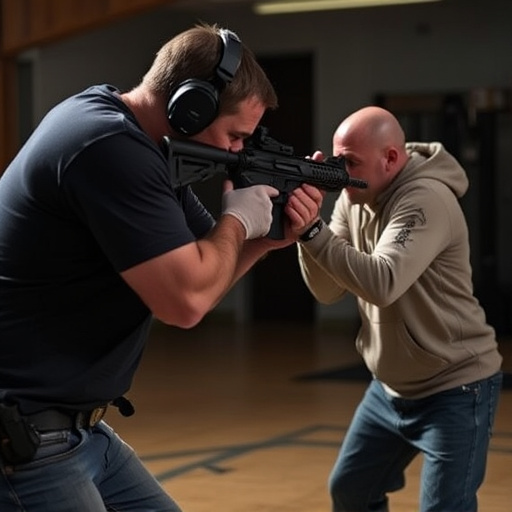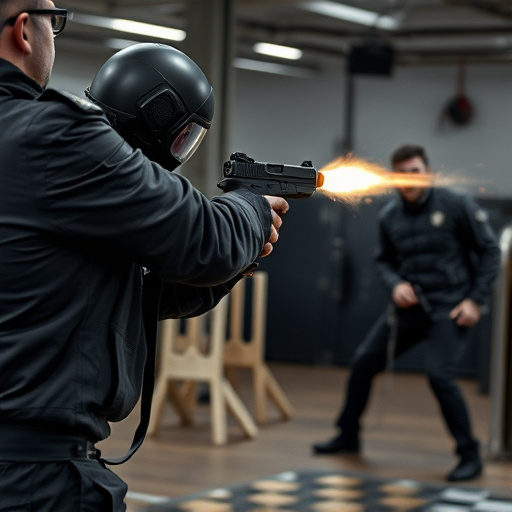Taser deployment, lasting 5-30 seconds, requires understanding battery duration for safety. Optimal stun gun battery life (up to 10 years) is achieved through regular cleaning, temperature control, and adhering to manufacturer guidelines. Proper maintenance, including calibration and user training, ensures consistent shocks, minimizes accidental discharges, and extends battery longevity for critical situations. Learn how to maintain stun gun battery life for peak performance.
“In today’s law enforcement and self-defense landscape, understanding the intricacies of taser deployment is crucial. This article delves into the critical aspect of paralysis duration following taser activation, offering insights that could save lives. We explore the physiological impact of tasers on the body, with a focus on factors influencing the length of paralysis. Furthermore, we dissect the relationship between battery health and taser performance, providing practical tips on how to maintain optimal stun gun battery life. Additionally, strategies for maximizing taser effectiveness during deployment are presented.”
- Understanding Taser Deployment and Paralysis Duration
- – What is the effect of a taser on the body?
- – Factors influencing paralysis duration
Understanding Taser Deployment and Paralysis Duration

Taser deployment is a significant tactical decision in law enforcement and self-defense scenarios, designed to temporarily incapacitate individuals who pose a threat. The device delivers an electric shock through two probes connected to electrodes, disrupting muscle control and causing immediate paralysis. However, understanding the duration of this paralysis is crucial for both safety and strategic reasons. Paralysis from a taser strike typically lasts for a brief period, ranging from a few seconds up to half a minute, depending on various factors such as the model of the taser, the amount of current delivered, and the target’s physical condition.
Maintaining optimal battery life in a stun gun is essential, not just for ensuring reliable deployment during critical situations but also for cost-effectiveness. Proper care involves regular cleaning, avoiding extreme temperatures, and adhering to manufacturer guidelines. Knowing how long the paralysis lasts allows users to assess risk levels and take appropriate follow-up actions. It’s important to note that prolonged or repeated taser use may lead to adverse health effects, emphasizing the need for trained professionals to make informed decisions when employing this technology.
– What is the effect of a taser on the body?

A Taser, or stun gun, delivers an electric shock that disrupts muscle control in the body, causing temporary paralysis. The effect is achieved through a high-voltage, low-current electrical pulse that interferes with the nervous system’s communication to muscles. This results in a powerful but brief incapacitation of the target. During deployment, the Taser probe tips inject small metal balls into the skin, establishing an electrical path between the device and the subject. The shock can cause muscle contractions, disorientation, and temporary loss of motor control, making it a potent tool for law enforcement and self-defense purposes.
Proper battery management is key to understanding how to maintain stun gun battery life. Taser guns rely on powerful batteries that deliver the required current for an effective stun. Regular maintenance, including cleaning and inspection, ensures optimal performance. Users should follow manufacturer guidelines for charging and storage, as improper care can reduce battery lifespan. Understanding the impact of environmental factors and usage frequency is also crucial in maximizing battery life, allowing individuals to rely on their Taser when needed.
– Factors influencing paralysis duration

The duration of paralysis caused by a taser deployment can vary significantly and is influenced by several factors. One key factor is the model and power output of the taser itself—more powerful devices may result in longer periods of incapacitation. Additionally, the distance between the operator and the target plays a crucial role; closer proximity generally leads to shorter paralysis times as the electrical current has less travel distance to disrupt nerve signals. Target size and physical build also matter; larger individuals might experience longer durations due to higher muscle mass conducting the electric charge.
Another important consideration is how to maintain stun gun battery life, which indirectly impacts paralysis duration. Regular calibration and testing ensure devices deliver the intended shock, while proper storage and care extend battery lifespan. Well-maintained tasers are more reliable, providing consistent performance during critical situations. Furthermore, understanding the device’s safety features and ensuring proper user training can minimize accidental discharge, optimizing both effectiveness and battery longevity.
Taser deployment triggers a powerful electrical impulse, temporarily paralyzing the targeted individual. The duration of this paralysis is influenced by various factors, such as the device’s settings and the subject’s physical attributes. To ensure optimal performance when relying on a stun gun, proper maintenance, including regular battery care, is essential. By understanding these considerations, users can make informed decisions to maximize the effectiveness and reliability of their taser equipment.
